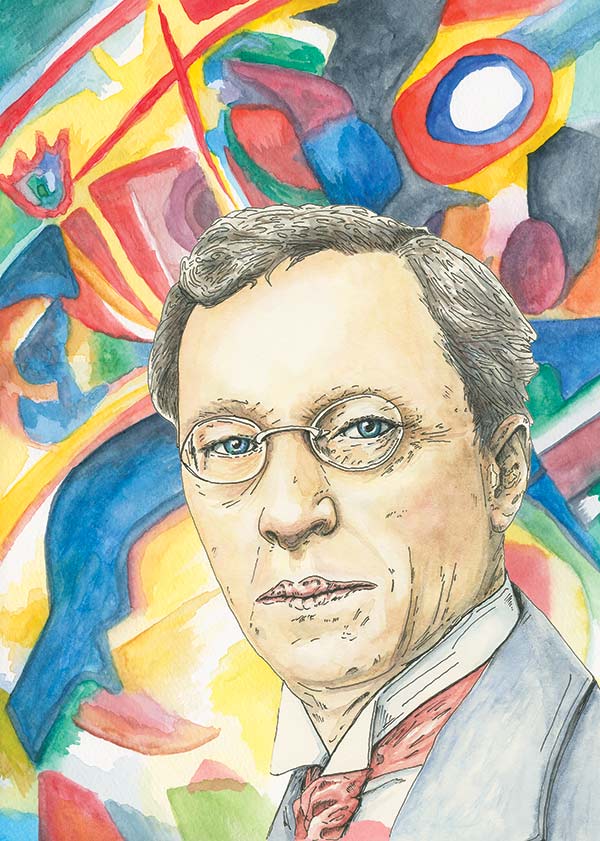Subtotal: $
Checkout-

Giant Picnic
-

Covering the Cover: The Art of Community
-

The Art of Community
-

Readers Respond: Issue 18
-

Family and Friends: Issue 18
-

I Did Not Leave
-

Summer of the Tree House
-

Warriors on Stage
-

The Beauty of Belonging
-

Insights on Beauty
-

It Could Be Anyone
-

All About Light
-

Making a Work of Art
-

The Business of the Artist
-

The Creative Process
-

Return to Appalachia
-

Excerpt: Mandela and the General
-

Why We Live in Community: A Manifesto
-

Editor’s Picks Issue 18
-

The Sacred Bonds of Sound
-

Making Music for Community
-

A Man of Honor

Next Article:
Explore Other Articles:
In 1896, when he was thirty years old, Wassily Kandinsky gave up a promising career as a law professor to begin painting. A native of Moscow, he moved to Munich and immersed himself in the city’s avant garde art scene. When war broke out in 1914, he returned to Moscow, but following the Revolution of 1917, he found that his Russian Orthodox spirituality was alien to the materialist ideology official Soviet art was required to embody. When, in 1921, Kandinsky was invited to teach at the Bauhaus arts school in Weimar, Germany, he left Russia for the last time.
The Nazis closed the Bauhaus in 1933, labeling its artists “decadent,” and Kandinsky fled to France. He died in Paris on December 13, 1944, having painted until the end.
Over the course of his career, his style developed radically: beginning in expressionism, he eventually painted one of the first purely abstract works in the European artistic tradition. True art, he believed, was not simply an accurate reproduction of external form – a house that looked like a house – but was something closer to a chord struck in the soul of the viewer.
Indeed, the link between music and art was crucial to Kandinsky’s work. Overpowered by Wagner’s Lohengrin, Kandinsky strove to call forth the same kind of experience in his viewers that Wagner’s music had given him.

Jason Landsel, Wassily Kandinsky
This experience must be the result of the artist communicating the “inner necessity” of both his own soul and the historical moment to the viewer. Artists, for Kandinsky, were prophets: they pointed the way toward a future of transformation, even of apocalypse.
Kandinsky was raised in the Russian Orthodox Church, and his faith was an integral part of his work. In his insistence that visual art must be a doorway to spiritual experience, one can see the influence of Orthodox theology of the icon. And in his rejection of materialism, one can hear the joy of an affirmation of Christian faith. In his 1910 essay “On the Spiritual in Art” he wrote:
Our minds, which are even now only just awakening after years of materialism, are infected with the despair of unbelief, of lack of purpose and ideal. The nightmare of materialism, which has turned the life of the universe into an evil, useless game, is not yet past; it holds the awakening soul still in its grip. Only a feeble light glimmers like a tiny star in a vast gulf of darkness.
To nourish that feeble light, to give hope to people who had succumbed to the nineteenth century materialist mirage, was the prophetic role of the artist to which Kandinsky felt called.
The betrayal of this prophetic calling could be seen in the inauthentic, purely external art that Kandinsky saw in the exhibitions around him. “A Crucifixion,” he lamented, “by a painter who does not believe in Christ.” Using the remedies of color and shape, Kandinsky wanted to bring about spiritual restoration. And he was confident that his audience wanted the same. He hoped, he said, that those seeing his paintings would “turn away from the soulless life of the present towards those substances and ideas which give free scope to the non-material strivings of the soul.”
Already a subscriber? Sign in
Try 3 months of unlimited access. Start your FREE TRIAL today. Cancel anytime.
































